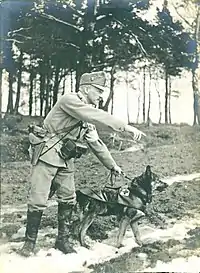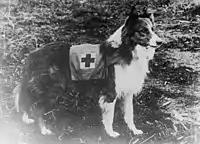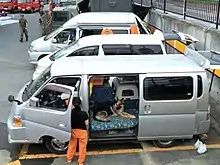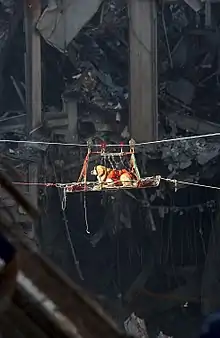Search and rescue dog
Search and rescue dogs are valuable after natural disasters, mass-casualty incidents, and for locating missing people. Dedicated handlers and well-trained dogs are required. Search and rescue dogs are typically worked by a small team on foot.


Search and rescue dogs detect human scent.
SAR dogs have been known to find people under water, under snow, and under collapsed buildings. Sending in SAR teams after avalanches, mudslides and earthquakes can mean the difference between finding someone alive or recovering a body.[1]
Types
.jpg.webp)
From their training and experience, search and rescue dogs can be classified broadly as either air-scenting dogs or trailing (and tracking) dogs. They also can be classified according to whether they scent discriminate, and under what conditions they can work. Scent discriminating dogs have proven their ability to alert only on the scent of an individual person, after being given a sample of that person's scent. Non-scent discriminating dogs alert on or follow any scent of a given type, such as any human scent or any cadaver scent. SAR dogs can be trained specifically for rubble searches, for water searches, or for avalanche searches.
Air-scenting dogs use general human scents to home in on any subject, whereas trailing dogs rely on scent of the specific subject. Air-scenting dogs typically work off-leash. They are usually, though not always, non-scent-discriminating (e.g., locate scent from any human as opposed to a specific person), and cover large areas of terrain. These dogs are trained to follow diffused or wind-borne scent working perpendicular to the wind, then to indicate their find (for example, by sitting with the lost party and barking until the handler arrives, or by returning to the handler and indicating contact with the subject, and then lead the handler back to the subject). Handler technique, terrain, environment (vegetation), and atmospheric conditions (wind speed and direction, temperature, humidity, and sky conditions) determine the area covered by air-scenting dogs, although a typical search area may be 40–160 acres and scent sources can be detected from a distance of 1/4 mile or more. Although other breeds can be trained for air-scenting, the prototypical air-scenting dog is a herding (e.g., German or Belgian Shepherd Dogs, Border Collies) or sporting (e.g., Tollers, Golden, Labradors or Springer Spaniels) breed that has a reputation for working closely and in coordination with a human handler.
Tracking
Tracking dogs will typically work on lead and will mostly have their nose to the ground, track or the rubble following ground disturbance. A good tracking dog will be able to work through a variety of terrain as well as successfully maneuver turns and "double backs" that a subject might take.
Trailing
A trailing dog that is scent specific, can also have his/her head up using some of the air scent techniques to find the subject. Trailing dogs will work on lead, and trailing dogs will venture off the actual path that a subject took should a scent pool be discovered. This is not to be considered an error by the dog, as they are following a specific scent and working through all other human scents to get to the source. It is a common misconception that only German Shepherd Dogs, Doberman Pinschers and Bloodhounds do this type of work.
All dogs are capable of tracking and trailing; larger, sport, hound, working and herding breeds tend to be used more often simply for their adaptability in various terrain.
Variations
In addition to these types of dogs, some teams cross train dogs in both trailing and airscenting and use them as scent specific "area searches". Typically these dogs are worked in an area that an airspace dog would work, but are capable of ignoring other search teams and other people in or near the assigned search area. When deployed this way, these airscenting dogs require a scent article as does a trailing dog. These dogs train every day and are very hard workers.
Applications

Specific applications for SAR dogs include wilderness, disaster, cadaver, avalanche, and drowning search and rescue or recovery.
In wilderness SAR applications, dogs can be deployed to high-probability areas (places where the subject may be or where the subject's scent may collect, such as in drainages in the early morning) whereas tracking/trailing dogs can be deployed from the subject's last known point (LKP) or the site of a discovered clue. Handlers must be capable of bush navigation, wilderness survival techniques, and be self-sufficient. The dogs must be capable of working for 4–8 hours without distraction (e.g., by wildlife).
Disaster dogs are used to locate victims of catastrophic or mass-casualty events (e.g., earthquakes, landslides, building collapses, aviation incidents). Many disaster dogs in the US are trained to meet the Federal Emergency Management Agency K9 standards for domestic or international deployment; advanced agility and off-lead training are prerequisites reflecting the nature of these dogs' application. Disaster dogs rely primarily on airspace, and may be limited in mass-casualty events by their inability to differentiate between survivors and recently deceased victims.

A dog with aptitude for finding dead bodies or body parts, whether buried, hidden or submerged, may be called a "cadaver dog".[2] In Croatia such dogs have been used to find burial sites almost 3000 years old.[3]
Avalanche dogs
Avalanche dogs work similarly to airscenting, disaster, or cadaver dogs, and must be able to rapidly transition from a wilderness SAR-airscenting scenario to a disaster scenario focused on pinpointing the subject's location. An Avalanche dog's main responsibility is usually to find humans that are trapped under snow. Some avalanche dogs can smell people that are under 15 feet of snow. Some dogs that are used for this job are St. Bernards, German Shepherd Dogs, and Labrador Retrievers.[4]
Training

Training of a search dog is usually begun when the dog is still a puppy.[5]
Organizations
Numerous countries, cities and regions have search and rescue organizations using dog-and-handler teams that can be mobilized in an emergency or disaster. Here are a few organizations.
- International Rescue Dog Organisation (IRO) is the worldwide umbrella organisation for training and testing of search and rescue dog work. IRO partners with International Search and Rescue Advisory Group and United Nations for coordinating disaster relief missions worldwide.[6]
- FEMA Urban Search and Rescue Task Force, US teams of dogs and handlers which are deployed to emergency and disaster sites within hours.
- Emergency Response Team Search and Rescue respond to emergencies and disasters in United Kingdom and Canada.
- Special Tasks and Rescue Dog Operations Unit supports the South Australia Police with tracking, searching, and finding lost persons.
Notable dogs
- Beauty, a wired haired terrier, was a search and rescue dog during the Second World War in England.
- Jake, a Labrador Retriever, was a search and rescue dog that worked the disasters of September 11 attacks (2001) and Hurricane Katrina (2005).
- Orion, a Rotweiller, helped save the lives of at least 37 people in 1999 from drowning during flash floods in Vargas, Venezuela.[7]
- Rex, entered burning buildings to find trapped people during the Second World War in England.
- Mancs, a German Shepherd trained to find people buried by earthquakes.
Dog breeds with a breed history of being search and rescue dogs includes the Alpine Spaniel (extinct) and the St. Bernard.
See also
- Nosework
- Working dog – Dog used for work
- Search and rescue horse
References
- Lockett, Michael S. (November 4, 2019). "Keeping a nose out: SEADOGS takes guesswork out of searches". Juneau Empire.
- Komar, D. (March 9, 1999). "The use of cadaver dogs in locating scattered, scavenged human remains: preliminary field test results". Journal of Forensic Sciences. 44 (2): 405–408. PMID 10097372 – via PubMed.
- Dogs show a nose for archaeology by sniffing out 3,000 year old tombs The Guardian, 2019
- "What Dog Breeds Make the Best Search and Rescue Dogs?". Animal Den. Retrieved 28 March 2014.
- "Training Dogs & Handlers". Canadian Search Dogs. Archived from the original on 1 May 2006. Retrieved 8 January 2021.
- "Strong Partners". International Rescue Dog Organisation.
- "Orión, el perro rescatista en la tragedia de Vargas (Orion, the rescue dog in the Vargas tragedy)" (in Spanish). December 11, 2014. Archived from the original on December 16, 2014.
External links
| Wikimedia Commons has media related to Search and rescue dogs. |
.jpg.webp)